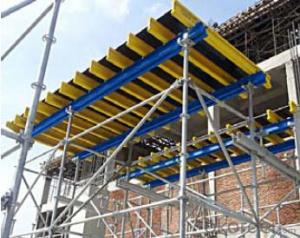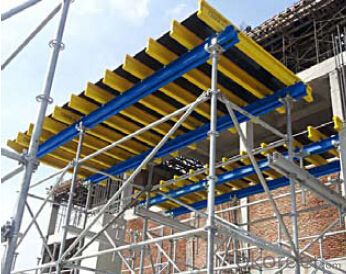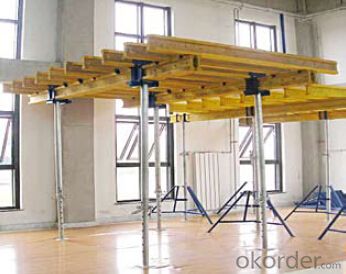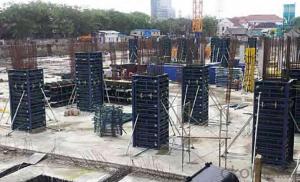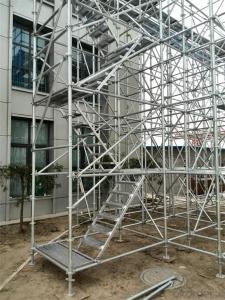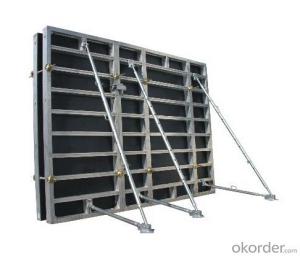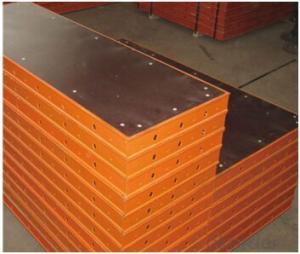Table formwork system for build
- Loading Port:
- China Main Port
- Payment Terms:
- TT OR LC
- Min Order Qty:
- -
- Supply Capability:
- -
OKorder Service Pledge
OKorder Financial Service
You Might Also Like
Tabel Formwork:
Table formwork is the most typical application for slab, with timber beam, the slab formwork is
light weight, fast and economic in the construction.
Characteristics:
◆ Simple structure, easy assembly.
◆ Flexible structure, be adapted to different support system.
◆ High construction efficiency with special system tools.
1. Lifting fork for lifting the table formwork to upper floor.
2. Trolley for moving the table formwork on floor.
◆ Flexible application with stand alone props.
◆ Safer condition with handrails.

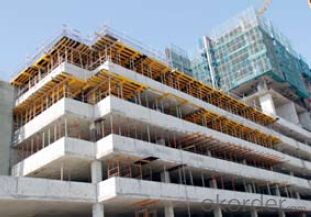
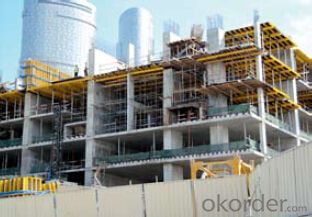
- Q: When the span of the main girder in steel frame is large, it is necessary to arrange the secondary beam
- The floor of the steel frame, the spacing of the secondary beam to the structure of the board material
- Q: What are the different types of form ties used in conjunction with steel frame formwork?
- There are several different types of form ties that are commonly used in conjunction with steel frame formwork. These form ties are essential for securing the formwork panels together and ensuring the stability and strength of the formwork system. 1. Loop Ties: Loop ties are one of the most commonly used types of form ties. They consist of a steel wire loop that is inserted through the formwork panels and then twisted or bent to secure the panels together. Loop ties are flexible and can accommodate different formwork configurations. 2. Flat Ties: Flat ties are another frequently used form tie. They are made of steel and have a flat shape, usually with holes or notches along the length. Flat ties are inserted through the formwork panels and secured using a wedge or a pin. They provide a strong connection between the panels and help maintain the formwork's structural integrity. 3. Snap Ties: Snap ties are a type of form tie that is designed for quick and easy installation. They consist of a metal rod with a button-like end that snaps into a plastic cone or washer. Snap ties are commonly used in applications where fast assembly and disassembly of the formwork is required. 4. Coil Ties: Coil ties are form ties made from coiled steel wire. They are typically used in situations where a high load capacity is required. Coil ties can be easily inserted through the formwork panels and secured using a coil nut or a coil rod. They provide a reliable and durable connection between the panels. 5. Cone Ties: Cone ties, also known as taper ties, are form ties that have a cone-shaped end. The cone end is inserted through the formwork panels and then secured using a wedge or a pin. Cone ties are commonly used in applications where a smooth and flush finish is desired, as the cone end can be easily removed after the concrete has cured. Overall, the choice of form tie depends on the specific requirements of the project, including factors such as load capacity, ease of installation, and desired finish. It is important to select the appropriate form tie to ensure the stability and strength of the steel frame formwork system.
- Q: How does steel frame formwork help in achieving consistent concrete quality?
- Steel frame formwork helps in achieving consistent concrete quality by providing a stable and rigid structure that holds the concrete in place during the pouring and curing process. This formwork system ensures accurate and uniform placement of concrete, preventing any deformation or movement that could result in inconsistencies in the final product. Additionally, the steel frame formwork allows for precise control of the concrete's shape and dimensions, ensuring a consistent and uniform appearance.
- Q: Can steel frame formwork be used in projects with limited construction site access or transportation challenges?
- Yes, steel frame formwork can be used in projects with limited construction site access or transportation challenges. Steel frame formwork is known for its durability and strength, making it suitable for various construction projects. Unlike other types of formwork, steel frame formwork can be easily disassembled and transported to different locations. This feature makes it ideal for projects where there are transportation challenges or limited access to the construction site. Additionally, steel frame formwork can be customized to fit specific project requirements, allowing for efficient and accurate construction. Overall, steel frame formwork is a versatile and practical solution for projects with limited construction site access or transportation challenges.
- Q: Can steel frame formwork be used for both small and large-scale construction projects?
- Yes, steel frame formwork can be used for both small and large-scale construction projects. Steel frame formwork offers high strength and durability, making it suitable for a wide range of construction projects, regardless of their size or complexity. Additionally, steel frame formwork is versatile and can be easily adjusted and customized to meet the specific requirements of different construction projects.
- Q: In the process of construction of reinforced concrete frame structure, the main contents of the quality inspection and monitoring of formwork engineering
- The specifications, quality and fastening conditions of all kinds of connecting pieces and supporting parts (the use of torque wrench for fasteners); 3, the overall stability of the supporting points and the combined steel formwork;
- Q: What is the level of precision that can be achieved with steel frame formwork?
- The level of precision that can be achieved with steel frame formwork is generally high. Steel frame formwork provides a rigid and sturdy structure that allows for accurate and precise concrete placement. The steel frames are designed to be straight, flat, and dimensionally stable, ensuring that the formwork maintains its shape and dimensions throughout the construction process. With proper installation and alignment, steel frame formwork can achieve precise results in terms of wall thickness, flatness, and surface finish. The tight joints and connections of the steel frames help in minimizing any potential leakage or seepage of concrete, resulting in a consistent and uniform appearance. Additionally, steel frame formwork allows for easy adjustments and modifications, enabling precise alterations in dimensions and shapes as per the construction requirements. This flexibility ensures that the final product meets the desired level of precision. However, it is important to note that achieving a high level of precision also depends on factors such as the quality of the steel frame formwork, the skill and expertise of the construction crew, and proper supervision and quality control measures.
- Q: Can steel frame formwork be used for both cast-in-place and precast wall construction?
- Yes, steel frame formwork can be used for both cast-in-place and precast wall construction. The versatility of steel frame formwork allows it to be easily adjusted and adapted to different construction methods, making it suitable for both cast-in-place and precast wall construction.
- Q: Can steel frame formwork be used for multi-story buildings?
- Yes, steel frame formwork can be used for multi-story buildings. Steel frame formwork is a versatile and durable construction technique that offers several advantages for multi-story buildings. Firstly, steel frame formwork provides strength and stability to support the weight of multiple floors. It can withstand the high loads and pressures generated by the different construction stages and the weight of the building itself. This makes it suitable for constructing tall buildings with multiple stories. Secondly, steel frame formwork allows for efficient and precise construction. The modular nature of steel formwork systems enables quick assembly and disassembly, saving time and labor costs. It also allows for flexibility in adapting to different floor layouts and structural designs. Additionally, steel frame formwork provides a smooth and even finish to the concrete structure, ensuring high-quality construction. The steel panels are typically coated or treated to prevent rust and corrosion, ensuring the longevity and durability of the formwork system. Furthermore, steel frame formwork can be reused multiple times, making it a cost-effective choice for multi-story buildings. Unlike traditional timber formwork, steel formwork can be easily dismantled, cleaned, and reused for future projects, reducing waste and saving resources. In conclusion, steel frame formwork is a suitable and efficient choice for multi-story buildings. Its strength, durability, versatility, and cost-effectiveness make it an ideal construction technique for constructing tall structures with multiple floors.
- Q: Can steel frame formwork be customized to meet specific project requirements?
- Yes, steel frame formwork can be customized to meet specific project requirements. The steel frames can be designed and fabricated according to the dimensions and specifications required for a particular project. Additionally, various accessories and attachments can be added or modified to suit the specific needs of the construction project.
Send your message to us
Table formwork system for build
- Loading Port:
- China Main Port
- Payment Terms:
- TT OR LC
- Min Order Qty:
- -
- Supply Capability:
- -
OKorder Service Pledge
OKorder Financial Service
Similar products
Hot products
Hot Searches
Related keywords
